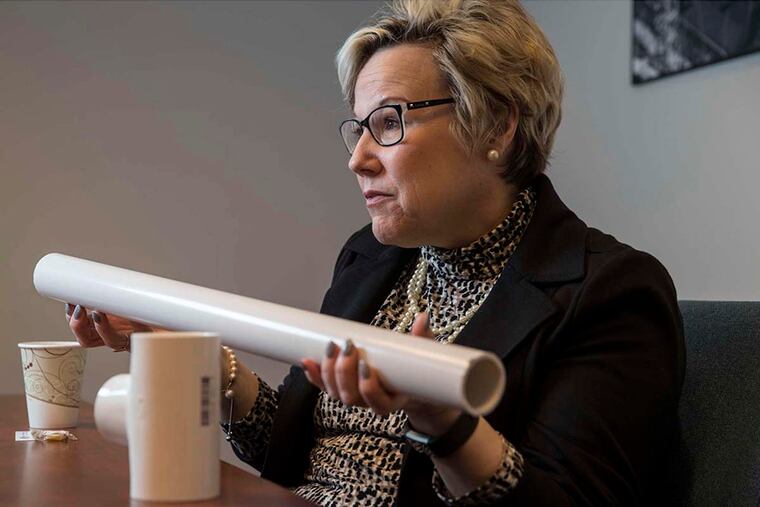Kathie Morgan
Katharine "Kathie" Morgan, 54, doesn't like to think she was a bad mother. But one day, when her son, now 17, was a toddler, she lifted him into her shopping cart's big basket and wheeled him through the supermarket.

Katharine "Kathie" Morgan, 54, doesn't like to think she was a bad mother.
But one day, when her son, now 17, was a toddler, she lifted him into her shopping cart's big basket and wheeled him through the supermarket.
"And out [of the basket] he went and hit his head," said Morgan, incoming president of ASTM International, the West Conshohocken-based nonprofit that convenes committees that set voluntary performance, design, and safety standards for 12,000 products and materials in 90 sectors.
"It wasn't more than a month later, coincidentally, when we began standards [development] for the restraint in the shopping carts in the top seat and the labeling for what's on it. The picture and the labeling, that's an ASTM standard," she said.
The products and materials vary widely. The petroleum committee alone has thousands of international members, including manufacturers, regulators, and consumer advocates. Subcommittees deal with automotive fuel, aviation fuel, lubricants, and additives.
A different subcommittee sets voluntary standards for furniture safety, including requirements and tests to prevent tip-overs of bureaus.
Tip-overs have been in the news lately as Ikea has been blamed for problems with its dressers falling over, causing the deaths of seven children.
The standard mandates wall restraints and requires furniture to remain stable when all drawers are open and a 50-pound weight is hung across a drawer.
Describe ASTM's process. You don't actually set the standards, right? You convene the experts.
We have the manufacturers, the retailers, the Consumer Product Safety Commission. We have consumers who have had children that were involved in incidents of tip-overs. They are continually reviewing the data from the commission on the incidents - what's happening, how are they happening, and what can standards do to reduce the incidents. It's hard. Some things are standards-related, and other things are not.
I had a child. I don't think I ever attached any of my dressers to the wall with those hooks. I guess I'm just really fortunate that my son didn't climb any of the drawers to get to something and that it didn't topple on him.
What pressures come to bear on setting standards?
Invariably, what comes up is cost of consumer products. You can design so much safety into a product that the cost goes up. Then, what is the consumer going to do? Are they going to buy the more expensive product that meets the standard, or are they going to buy a product that is half the cost, but doesn't meet the standard?
Do manufacturers participate for marketing or litigation avoidance?
They participate because the standard is going to impact their selling their product, maybe meeting regulations. They want to influence the content of the standard. Remember, too, the standard that comes out is not just a manufacturers' standard - the retailers have been there, the consumer product safety commission is there, the advocacy groups, consumers.
How do you bring all these points of view together into one standard?
They all come in with a bias. Our process takes the debates and sorts them, somehow, through a parliamentary process that produces a consensus document. It's not unanimous.
What's the greatest challenge facing ASTM?
To remain relevant to the stakeholders. We have to respond to new areas like additive manufacturing (3-D printing), nanotechnology, and industrial biotechnology. Standards commoditize innovation. As innovation and technology advance, how that technology comes to market is through standards.
Do you have standards in your home?
I'm obsessed with organization. Things have a place, and they need to be in the place. I'm not concerned if there is dust on my furniture.
What's the standard for dirty dishes in the sink?
Zero. I don't like even a spoon sitting in the sink.
Interview questions and answers have been edited for space.
215-854-2769 @JaneVonBergen